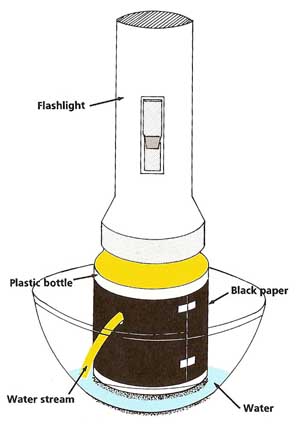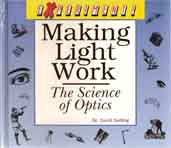MAKING LIGHT WORK: The Science of Optics - 2. Through the Looking Glass
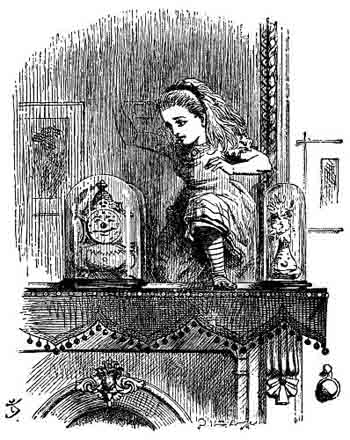
Figure 1. Alice pushes through the mirror in Through the Looking Glass.
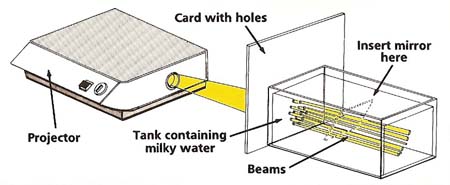
Figure 2. Molecules in a solid, a liquid, and a gas.
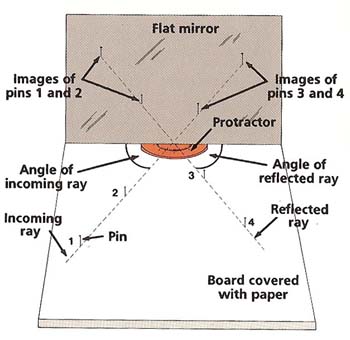
Figure 3. Ray tracing.
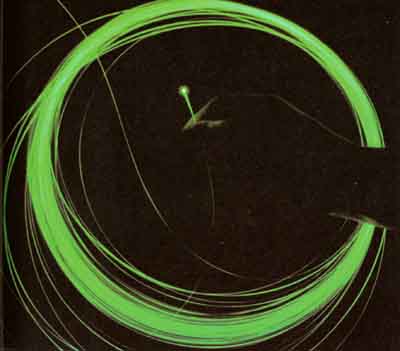
Figure 4. Light passing through an optical fiber.
As Alice found in Lewis Carroll's famous story, there are many surprises waiting through the looking glass. Mirrors are not only useful, they are fun to experiment with as well.
All substances reflect, or bounce back, some of the light that falls on them. But usually the light is scattered in al directions so that the surface appears dull. If the reflecting surface is very smooth and polished, however, it bounces the light back in a regular way. It acts as a mirror.
Mirror, Mirror on the Wall
Glass can be made very flat and smooth. But it does not reflect well. It bounces back only about one-twentieth of the light that falls on it. However, you can turn a window pane into a mirror simply by taping a piece of aluminum foil to one side of the glass. Looking from the other side of the window you will now see a reflection of yourself. It is a fairly poor reflection because the foil does not fit closely enough to the flat surface of the glass.
Proper mirrors are not made by using foil but by coating the back of a piece of glass directly with metal. Silver is normally used because it reflects well and there is a process by which it can be applied easily to glass as a thin, even layer. The glass gives a smooth surface for the silver to cling to and also protects the silver from tarnishing.
Reflections and Images
The reflection of an object in a mirror is called an IMAGE. An image always appears to be the same distance behind a flat mirror as the object is in front.

The Topsy-Turvy World of MirrorsYou will need:
What to do:
Look at yourself in the mirror. Raise your right hand. Which hand does the person in the mirror lift? The mirror seems to swap right for left. But why does it not also swap top for bottom? Look more closely. Your right hand is still the same hand in the mirror. What the mirror has really done is turn your hand around front to back.
Place a ruler so that one end is touching the mirror. Notice that the reflection of the ruler in the mirror is pointing in the opposite direction. Now, place your finger next to the line showing 6". What is the finger in the mirror pointing at? Point at the line showing 9" and check what the mirror finger is doing. What can you deduce about the distances of objects and their reflections on either side of the mirror?
Taking it further:
To see yourself as other people see you requires two mirrors. Set up the mirrors at right angles. Now your reflection in the first mirror is reflected again in the second mirror. This turns all your features, your hair, and so on, the right way round so that they appear as in real life.
Look at your "real lfe" reflection and try to touch you left eye with your right hand. If you have difficulty, why do you think this should be?
Arrange the two mirrors so that they are facing one another with your head in between. Try to explain what you see.
Using the protractor, set up the mirrors so that they make angles of 60 degrees, 45 degrees, and 30 degrees. Describe the number and type of reflections you see. |

A Beam TankYou will need:
What to do:
Partly fill the container with water and add a few drops of milk to produce a slightly cloudy mixture. Place the container on a dark surface. Position the light source about a foot away from the container so that the beam shines level through the water (see Figure 2).
Poke a number of small holes in the card so that when the card is placed in front of the beam the light shines through. Set up the card at the side of the tank facing the beam. Darken the room as much as possible. Look down from directly above the tank and you should see several narrow beams of light.
Hold a mirror upright in the path of the narrow beams. What happens as you alter the angle the mirror makes to the incoming light?
Introduce the second mirror so that it stands upright in the path of the reflected beam from the first. Observe what happens as you turn this second mirror. Turn both mirrors at once to control the direction of the final beam.
Taking it further:
Suggest and investigate ways in which your beam tank could be improved.
It is not easy making beams clearly visible. This is because most of the light is travelling in the direction of the beam and can only be seen by someone looking along that line. The trick is to scatter enough light out of the beam to make it visible from the side without weakening the beam too much. This can be done using very fine particles of matter.
In the "beam tank described above, particles of milk, suspended in water, provide the scattering material. An alternative method is to use smoke from a smoldering piece of string or a blown-out candle. But smoke is difficult to work with.
Another problem is to produce rays of light that are bright enough to be seen clearly and that penetrate reasonably far across the tank, It is most important to have an intense source of light such as a slide projector. The positioning of the light source also has an important effect on the quality of the rays in the tank.
Yet another factor is the number, size, and location of the holes in the card that produce the narrow incoming light beams. Finally, it is essential that no stray light enters the observing area as this greatly reduces the visibility of the light beams.
So, there are several aspects to the design and setup of the beam tank that need to be considered carefully. What is the ideal quantity of milk to add to the water? What is the best light source and where should it be placed? What is the most effective pattern and width of holes in the card screen? And so on. |

Ray TracingYou will need:
What to do:
Support the mirror securely so that it stands upright at the back of the board. Stick two pins upright in the board so that you can see their reflection in the mirror. Line up the images of the two pins and stick two more pins in the board exactly along this line (see Figure 3).
Remove all the pins. Draw a line to the mirror that passes through the holes made by the first two pins. This represents an incoming ray of light. Draw another line from the mirror that passes through the holes made by the second two pins. This follows the track of the reflected or outgoing ray. Use the protractor to measure the angle between the incoming ray and the mirror and the angle between the outgoing ray and the mirror.
Repeat the experiment with pins in different positions. Record your results on a chart. What do you conclude? |
Equal Angles
When you throw a ball at a smooth wall, it bounces off at the same angle as it hits. The same is true of light striking a flat mirror. Light rays are reflected from a mirror at the same angle as they arrive.

Glancing RaysYou will need:
What to do:
Place the slide so that it is at right angles to the light rays in the tank. What happens to the rays?
Slowly rotate the slide. Notice what happens when the incoming rays meet the slide at a small glancing angle. Observe closely and describe what you see. How do your findings relate to the subject of optical fibers described below? |
Optical Fibers
A transparent or translucent material will reflect most of the light falling on it if the light approaches the surface of the material at a small enough angle. This fact makes it possible to send light for very long distances through narrow, flexible strands of glass called OPTICAL FIBERS. Light from a bright source travels along an optical fiber in a zigzag path. Instead of escaping, it hits the side of the fiber at a small angle and is reflected back inside (see Figure 4).
Today, optical fibers are often used to carry phone conversations and computer information in the form of tiny flashes of light. A bundle of optical fibers, no thicker than your little finger can carry tens of thousands of phone calls at once – more than a copper cable the thickness of your arm is capable of carrying.

Liquid Light
You will need:
What to do:
Cut the bottle in half and wrap the black card around the lower half, securing it with sticky tape. Make a hole with the end of the scissors about 3 inches from the bottom of the bottle. Place the bottle in the bowl. Darken the room. Fill the bottle with water and shine the flashlight into the bottle.
Observe what happens. Try to explain what yu see in terms of the way optical fibers work. How can you tell that the escaping water is not a very good optical fiber?
Caution: Take care when using scissors. Never point them toward you.
Taking it further:
The light from the flashlight in this experiment is channeled into the water escaping from the bottom of the bottle. Once inside the stream of water, the light zigzags its way along the flow as it is reflected again and again from the boundary between the water and the air. In this respect, the water acts as an optical fiber. But the fact that you can see the water lit up means that there must be a good deal of light escaping from the sides. Try doing this experiment over a bath or sink in a darkened room so that the water has much farther to fall. What height of water does it take before almost all the light has 'leaked. away? You can also try making optical fibers from clear plastic tubing such as that used in aquariums. |

